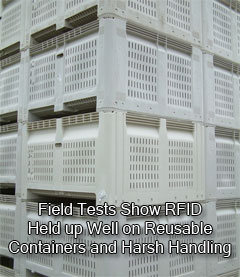RFID Provides Solution – but Will It Hold Up in Real World Conditions?
RFID tracking of the reusable containers certainly provides a potential answer to the tracking and asset management issues, which in turn can support an even stronger business case for the move to reusables.
While RFID has already been implemented by a number of companies to track re-usable logistics assets, there have been some lingering questions about whether RFID tags would really hold up under the challenging conditions to which reusable containers are often subject.
 In an attempt to answer that question, the Reusable Packaging Association (RPA), which obviously has an interest in seeing wider adoption of reusable platforms, contracted with several parties to conduct some fairly extensive testing of RFID tags attached to plastic totes under real world conditions. The summary result: the RFID tags held up extremely well in the test, under conditions that included low temperatures and significant water exposure, in addition to the rough handling the containers go through as a part of standard logistics flows. In an attempt to answer that question, the Reusable Packaging Association (RPA), which obviously has an interest in seeing wider adoption of reusable platforms, contracted with several parties to conduct some fairly extensive testing of RFID tags attached to plastic totes under real world conditions. The summary result: the RFID tags held up extremely well in the test, under conditions that included low temperatures and significant water exposure, in addition to the rough handling the containers go through as a part of standard logistics flows.
In the first step of the research, tags were applied to plastic totes and subject to a variety of tough handling conditions, such as drops and vibrations, by the researchers at Michigan State University School of Packaging.
Those totes were then shipped to another testing facility in Ohio, where the researchers there performed extensive read testing on the totes after they have been shrink wrapped on a pallet. All told, the project team performed more than 160 hours of testing and more than 14,000 tests, using a hand-held RFID reader.
According to the RPA, there were virtually zero issues with reading the tags after the stress tests at Michigan State. In fact, the RPA goes so far as to say that “In addition to proving durability, the data demonstrated that it is possible to get 100 percent read rates 100 percent of the time, which had never been achieved in the industry before.”
Tracking Lettuce
The next phase of the project involved an actual field test of the tagged containers. Tagged containers were sent to the farms of several different growers of produce, where lettuce was packed directly into the containers. From there, it went to a cooling facility, then loaded and shipped to the DCs of trial participant Wal-Mart, at an average distance of over 1000 miles. Wal-Mart processed the totes in its DCs, then loaded them onto trucks and delivered them to its stores.
According to the RPA, “This scenario required that the tags utilized on the assets must withstand considerable temperature swings, wet and cold environments, shipping vibration and other transportation challenges and be successfully read when entering into an end users distribution system.”
The tags on the totes were encapsulated in a plastic film, from two different suppliers. Tags from three different manufacturers (Alien Technology, UPM and Avery Dennison) were used.
Through the full logistics lifecycle, the RFID tags and totes underwent extreme changes in temperature, ranging from over 100-degrees Fahrenheit in the field to 32 degrees in cold storage and over 170 degrees when the containers were later washed.
Additionally, the RFID tags were exposed to dry field conditions, wet and cold storage environments and subject to a variety of handling processes as the totes moved throughout the supply chain.
In total, 110 totes were tracked through RFID scans at various points in the process, such as issuance from the growers DC, receipt at a Wal-Mart DC, and return to the grower’s DC. Field testing lasted more than a year. Of those 110 containers, 109 could still be consistently read after the field testing period, with readability defined as being read within three seconds while driving a pallet at a safe speed through an RFID dock door portal reader.
The RPA did say tag placement was important to achieving these results, but, at press time, SCDigest could not get any more details on the placement issue.
“The independent study concluded that RFID tags that are designed for single use could be used for multiple trips without any deterioration in performance if positioned correctly on reusable containers,” the RPA says.
Is this type of research useful for helping companies better understand long-term RFID performance? What other research would you like to see performed? Let us know your thoughts at the Feedback button below.
SCDigest is Twittering!
Follow us now at https://twitter.com/scdigest
|